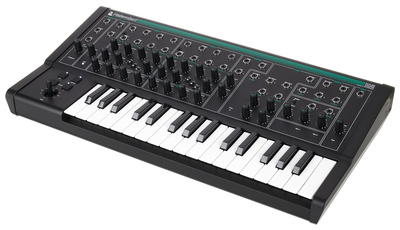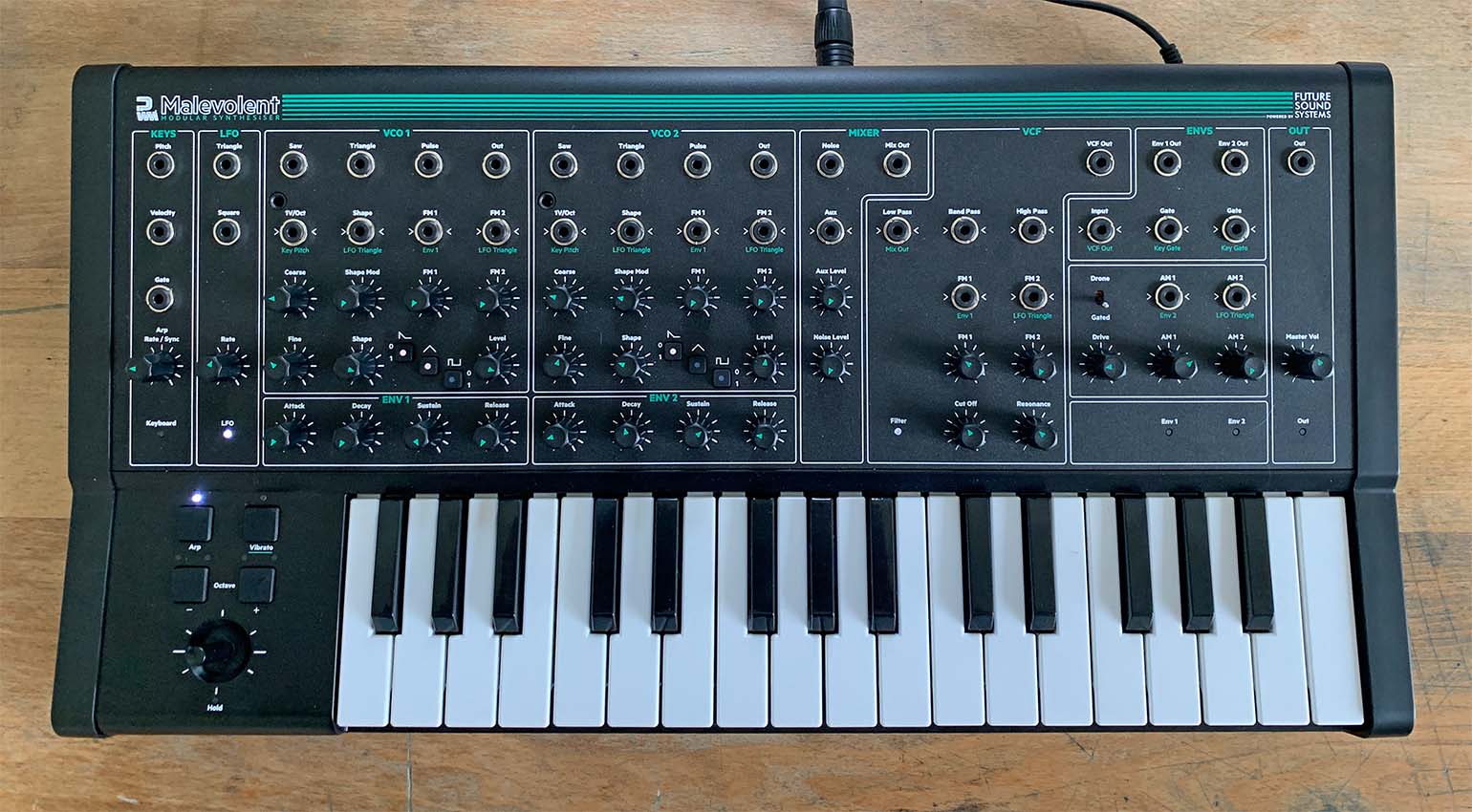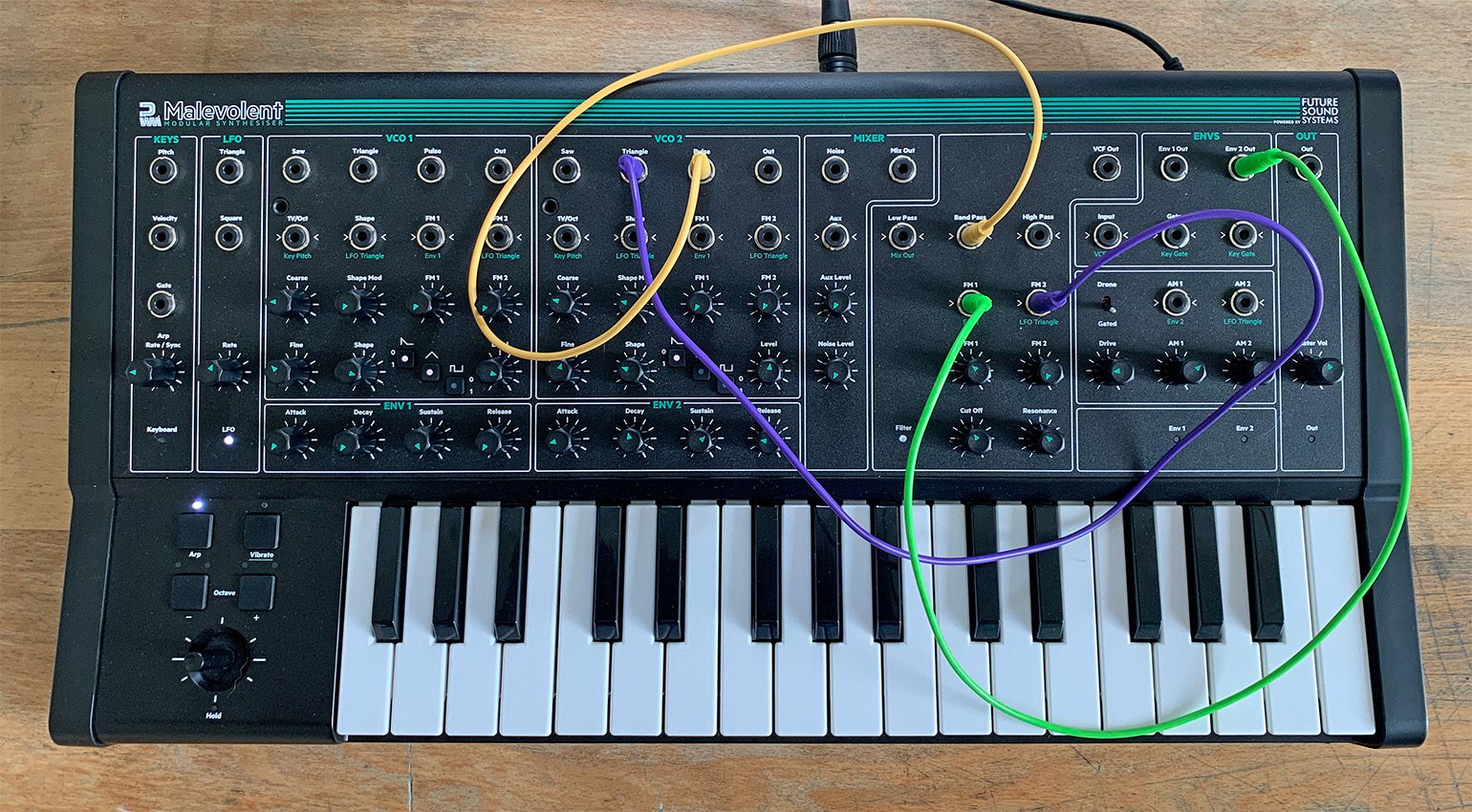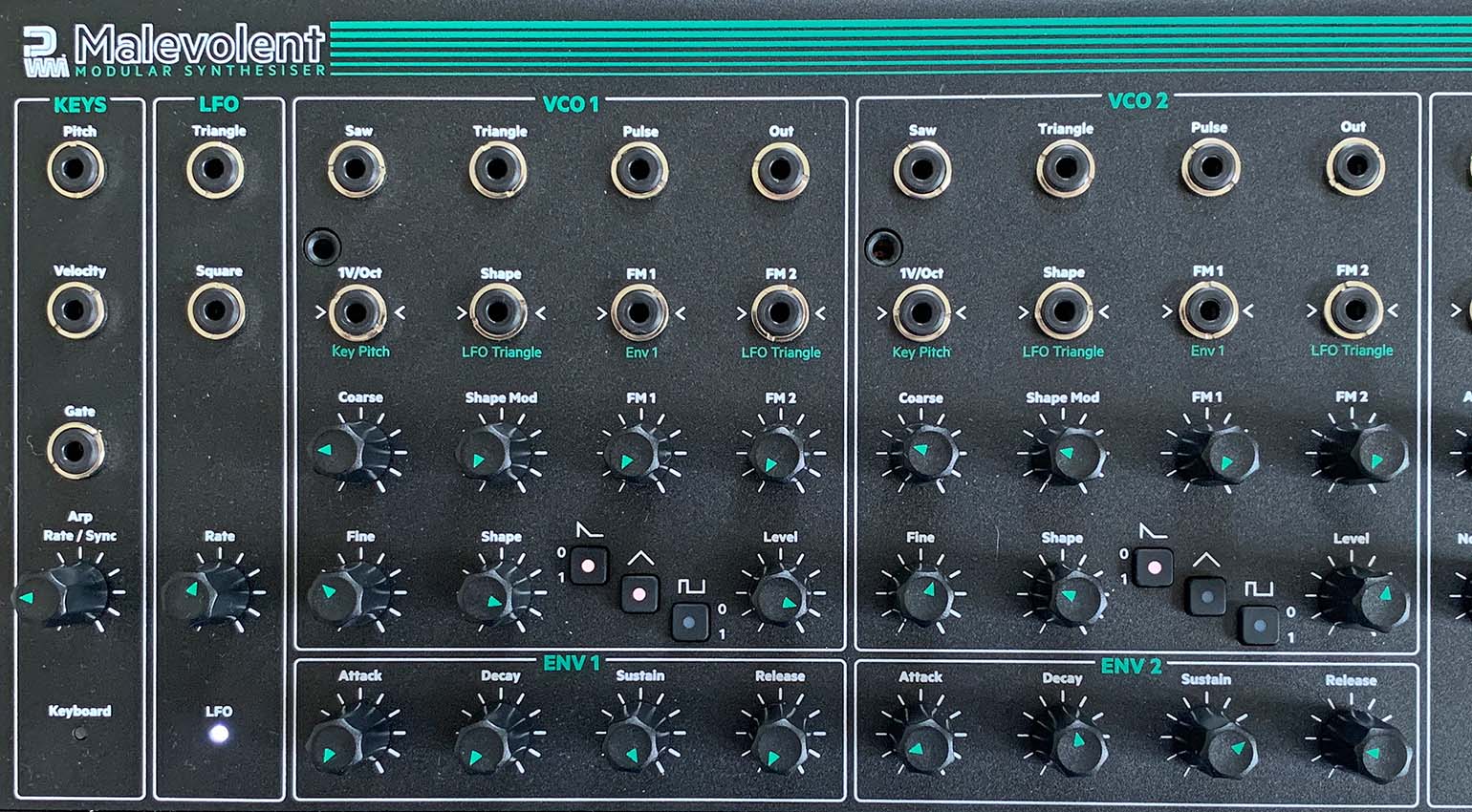First Look Review: PWM Malevolent – semi-modular analog synthesizer
The PWM Malevolent was the talk of the show at last year’s Superbooth. The affordable, semi-modular analog synthesizer features a no-nonsense design, plenty of patching opportunities and Eurorack compatibility. It was designed by Paul Whittington and Britain’s Future Sound Systems. Just a few months later, the PWM Malevolent is ready and we’ve got the opportunity to take it through its paces in our First Look Review.
PWM Malevolent First Look Review
It doesn’t happen every day that a previously unknown company pulls a brand new synthesizer from its hat and then manages to get it out to the dealers within just a few months. Sadly, many ambitious indie projects never make it beyond the Kickstarter stage. The Malevolent is different: it already looked pretty much finished when PWM went public with it, and it’s available only a short while later. In times of parts shortages and chaotic supply chains, PWM certainly deserves credit for this achievement.
Paul Whittington, the man behind the new company, previously worked for Novation and M-Audio. For his concept of a semi-modular synthesizer, he joined forces with Future Sound Systems, also from the UK. The result is a compact synthesizer with a two-and-a-half-octave keyboard that combines a proven, straightforward synthesis architecture with deep patchability. It’s quite obvious that one of the Malevolent’s biggest strengths lies in the combination with Eurorack systems. But there’s nothing stopping you from using it on its own. Let’s try it out and see if PWM’s debut is a success.
Concept
The PWM Malevolent is a monophonic analog synthesizer with 32 mini keys. While the manufacturer calls it “modular”, it’s actually a semi-modular synth with internally pre-wired audio and CV connections. This means that you can play it without using a single patch cable. That said, the real fun starts when you use the numerous jacks scattered across the panel to add your own CV and audio routings or replace the pre-wired connections with others. When you add external Eurorack modules into the mix, the possibilities are virtually limitless. The Malevolent gives you both: the advantages of a compact, self-contained instrument and the versatility of a modular system.
The basic building blocks of the synth are fairly standard: two oscillators with sawtooth, triangle and pulse waves, a noise generator, a mixer, a filter, two envelopes and “one and a half” LFOs (a full-fledged LFO and a dedicated vibrato LFO, which is controlled by the joystick). There’s also an arpeggiator with a choice of six patterns.
It’s a popular configuration similar to many other synthesizers. But the Malevolent shouldn’t be underestimated: despite the synth’s rather simple setup, the semi-modular design opens up many interesting sound design opportunities.
There’s a certain conceptual similarity to the Moog Grandmother – another semi-modular, patchable keyboard synthesizer with two VCOs. But when you take a closer look, the two synths are quite different. For example, the Malevolent’s oscillators offer more FM capabilities and the advantage of simultaneously available waveforms. It also has a completely different filter design. While the Malevolent lacks the Grandmother’s spring reverb, it features an extra envelope. But on the whole, it serves a similar purpose: a self-contained, patchable synthesizer with two VCOs that’s also a perfect add-on to a modular system.
Green machine
With a width of just under 50 centimeters and a tiny keyboard with 32 mini keys, the Malevolent roams in Microkorg territory. Fortunately, though, all jacks and controls are easily accessible and the panel feels much less claustrophobic than most Eurorack modules.
The workmanship seems decent enough. That said, the Malevolent can’t quite keep up with the look and feel of pricier instruments by Moog, Sequential and the like. The knobs feel a bit wobbly and the choice of materials cannot hide the fact that it’s a rather inexpensive synth. But it feels ok, and the magnetic side panels that you can simply pull off to access the case screws are a very cool idea.
Opinions about mini keys vary wildly, but I find the keyboard quite usable for the monophonic leads, basses and arpeggiator chords that you’re going to use the Malevolent for. If you want more, you can always control the synthesizer via USB, MIDI or CV/Gate. To the left of the keyboard is a joystick that controls pitch bend and vibrato. It also serves as a replacement for a sustain pedal and lets you select arpeggiator patterns.
Speaking of connections: On the back, there’s a USB-C port that receives and sends MIDI data. While this can also be used to power the synthesizer, there’s also a separate connector for the included power adapter, as well as MIDI In/Out, Clock In/Out, a headphone output and a line output.
The integrated (USB-)MIDI-to-CV interface offers outputs for pitch, velocity and gate, which can be assigned to various modulation destinations and/or used externally. The arpeggiator transmits MIDI, CV/Gate and Clock, which makes the synthesizer quite suitable as a universal keyboard and control center for a modular system.
Punk’s not dead
When I first started to play the Malevolent, it didn’t take me long to realize that the name does speak for itself. The little synth is delightfully brash and gritty and not shy at all. If you swear by the silky, full-bodied and well-rounded sound of a Moog, chances are that the Malevolent isn’t for you. But if you’re a fan of the MS-20, Wasp and the like, you’re sure to get your money’s worth. It’s not the most polished-sounding synth there ever was, but it’s great fun to play with.
The two identical oscillators are a big part of this. Both offer sawtooth, triangle and square waves, which can be selected with buttons and used simultaneously. The Shape control and corresponding CV input aren’t just for the square wave, but affect all three waveforms, which opens up a wide range of sonic textures. To my ears, the saw and square waves sound a bit thinner and more mid-rangy than I’m used to, but the triangle makes up for it with a powerful low end that’s ideally suited for laying a solid foundation.
An underlying theme of the Malevolent is that there’s a huge number of ways to get creative with frequency modulation. Each oscillator offers two FM inputs. These are pre-wired to Envelope 1 and the LFO, but you can patch in any modulation source you’d like. The oscillators can modulate each other, or you can use the noise generator or even an external source. Consequently, unique and aggressive FM sounds are one of the Malevolent’s sonic sweet spots.
The waveforms are then sent to the mixer via the oscillators’ level knobs. You can also grab individual waveforms from the corresponding waveform outputs for each oscillator. That’s great for FM purposes and also lets you achieve things like patching a sawtooth wave into the bandpass input of the filter, while the other waveforms go through the lowpass.
The mixer is also where you’ll find a knob for the noise generator. This also has its own output, so it can serve as a modulation source. There’s also an aux input for an extra audio signal (internal or external).
Civil disobedience
The second major component of the Malevolent’s aggressive sound is the filter. It’s a 12 dB Sallen-Key filter – a rather simple circuit that uses far fewer components than a Moog ladder filter, for example. And that might be the reason why I sometimes felt reminded of the MS-20: that synth’s famous filter is also based on the Sallen-Key design.
The filter has separate lowpass, bandpass and highpass inputs. If nothing else is plugged in, the output of the mixer feeds the lowpass input. And just like the oscillators, the filter offers two FM inputs. One of these is connected to Envelope 1 by default, and the other to the LFO. You can patch in any modulation source you’d like, for example the VCOs or the noise generator.
As for the sound and behavior of the filter, I’m a bit torn. The raw and unbridled sound does have an appeal, especially in aggressive leads or arpeggiator patterns. It’s not easy to tame, though. Not only does the filter reach self-oscillation pretty quickly (sometimes even when the resonance isn’t even halfway turned up). Everything also seems to affect everything else, which sometimes makes it difficult to get consistent results. For example, you might increase the filter input level ever so slightly, only to find that the filter suddenly reacts quite differently. On the one hand, I really enjoyed this roughness, and many of the Malevolent’s best sounds happen in situations like this, when the synth almost seems alive. On the other hand, it does take a while to get a feel for how the filter reacts to different settings, levels and patch connections.
Next is the VCA, where you’ll find a distortion circuit (just in case you wanted even more grit). And this wouldn’t be the Malevolent if there weren’t two modulation inputs here, as well. By default, inputs AM1 and AM2 are wired to Envelope 2 and the LFO; but you can patch in any AM sources you see fit.
The Malevolent sounds best if you let yourself be guided by its idiosyncrasies and, yes, by its limitations. Just experiment with patch connections and prepare to be surprised. It’s not the most polite synth out there, but it’ll reward you with many unique sounds that are as assertive as they are independent.
What’s missing?
Unfortunately, there are also a couple of missed opportunities. I think that this synthesizer could’ve been even better with a few little tweaks and additions.
For example, neither the LFO nor the VCOs offer sync. Oscillator sync would add a whole new layer to the Malevolent’s sonic palette, especially when paired with the extensive FM capabilities. And the LFO is disappointingly basic, as it only has two waveforms and lacks the ability to sync to the keyboard gate and to the arpeggiator/clock. Without sync, it’s basically useless for any kind of timed, rhythmic modulation, not to mention things like Sample&Hold.
What’s also missing is a way to invert the envelopes – or any modulation signal, for that matter. A patchable attenuverter would be a great addition. If you own a Eurorack system, you can always use a module to do this. But it would be even better if the synth offered it out of the box. This also applies to multiples, by the way: a simple set of passive jacks that lets you send a voltage to two or three different targets is something you’ll likely start wishing for pretty soon.
Conclusion: A strong personality
As a first effort by a new manufacturer, the PWM Malevolent semi-modular synthesizer is a very pleasant surprise. It’s affordable, approachable and patchable, and it has all the ingredients for a wide range of assertive leads, basses and arpeggios. Despite its limitations, it also offers many opportunities to venture off the beaten path thanks to its extensive FM capabilities, and it’s an excellent addition to any Eurorack system. It’s sound is definitely more punk than hi-fi, which is absolutely a good thing. My guess is that it’s going to be “love it or hate it”. If you’re into brash, slightly unruly synths with a strong personality, you’re going to love it. If you prefer a more refined, polished sound, however, chances are that it isn’t for you.
Price and availability
The PWM Malevolent is available at Thomann*.


More information about the PWM Malevolent
Videos
You are currently viewing a placeholder content from YouTube. To access the actual content, click the button below. Please note that doing so will share data with third-party providers.
You are currently viewing a placeholder content from YouTube. To access the actual content, click the button below. Please note that doing so will share data with third-party providers.
One response to “First Look Review: PWM Malevolent – semi-modular analog synthesizer”


 4,5 / 5,0 |
4,5 / 5,0 | 













I am shure Uli Behringer had Big eyes when He saw the price tag hanging on this synth…., 😂😂😂